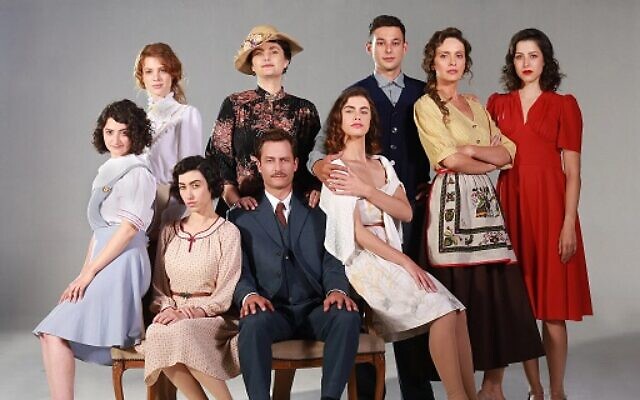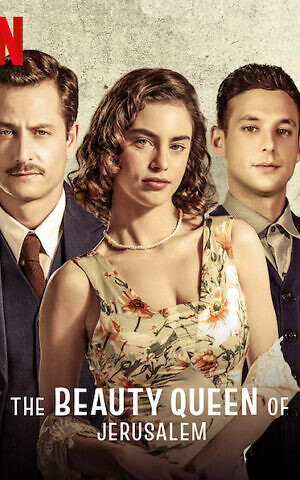Relationships Gluing Jewish Melodrama
Israeli TV series now on Netflix “The Beauty Queen of Jerusalem” depicts a Sephardic family life during Ottoman rule.
After 37 years with the Atlanta Journal-Constitution and now with the AJT, , Jaffe’s focus is lifestyle, art, dining, fashion, and community events with emphasis on Jewish movers and shakers.

As streaming services vie for loyal, if not obsessive viewers, Netflix has produced a subset of edgy, quasi-controversial Jewish content. The 20-part series, “The Beauty Queen of Jerusalem,” embroils audiences in a melodrama about a Sephardic family originally portrayed in an Israeli TV series and a book, of the same name, by Yishai Levy.
Besides the predictable, and more likely unpredictable, machinations of the Armoza family, much of the storyline focuses on the political and social climate of Palestine under Ottoman rule, followed by the British Mandate and then by a period of depression and war.
The thought-provoking parts of the series were juicy and varied. Between the Irgun and Hagana, who were the terrorists versus the good guys? Who looked down upon whom in the Sephardic/Ashkenazi matrix? What part of marriage is duty, love or acceptance of infidelity? What is the maximum level of tolerance of an interfering mother as the family kingpin, and can the audience dare to like her?
As the beauty queen, life can be ever so fashionable: dancing, courting, plotting and running the town’s gourmet store…until it isn’t. Soldiers don’t come back from war. The Jewish, mystic witch doctor bathes evils in cow intestines and serves as the truth teller. It’s all so deliciously addictive, wrapped in a Ladino bow with husbandly jaunts to Beirut, mingling in opium dens in a house of ill repute. It’s hard to turn away from a train wreck clothed in Jewish tradition and historical back drop.
Contemporary Sephardic woman Suzanne Eisenberg related, “’The Beauty Queen of Jerusalem’ magnifies the tensions between the Ashkenazi and Sephardic Jews in Israel during the British rule and suggests that the Sephardi Jews in Jerusalem were wealthier and had more influence than the Ashkenazi. Many of the former during the British rule were from Spain and Portugal and had been there for hundreds of years when they were forced out during the Spanish Inquisition.”

Although the Sephardi Jews are portrayed as more established, outside of Jerusalem, the kibbutz movement was becoming popular, as was the push for Israeli statehood. Most of the Jews from these two movements were predominantly Ashkenazi.
One discrepancy in the show is how the guerilla groups of the time, like the Irgun and Haganah, are portrayed as dangerous terrorists when, in reality, many were hailed as heroes by the Jews living in Palestine.
The fact that the series barely mentions the rising antisemitism and Nazism in Europe at the time was disturbing. The Grand Mufti of the Middle East was very antisemitic and incited the Arabs, which led to revolts and massacres of Jews in the 1920s and 1930s.
Many British officials in the series are shown as benevolent, free of prejudice toward the Jews or Zionists. That is a major historical inaccuracy. After 1948, most Sephardim were forced out of Arab countries and became refugees in Israel but were not depicted as such in the series. Some were not as elitist as the Sephardic Jews in “Beauty Queen.” They were heavily discriminated against and had to work hard to advance in Israeli society, which was mostly dominated by post-Holocaust Ashkenazi refugees.
Egyptian-born octogenarian Laurette Hanein noted that the cuisine and customs in the series were realistic. “The foods shown included a very popular dish: macaroni hamin, a stew of noodles and chicken cooked overnight; sofrito, a meat and potato dish; huevos haminados, or hard-boiled eggs cooked overnight; borekitas, or small cheese pastries; rice pudding; sutlac; and ring-shaped cookies.”
Fans Janet and Hilton Kupshik said, “After the first few episodes, we became fascinated and found it exciting. The characters really drew us in.”
Can’t get enough? Stay tuned for the second season which began shooting in June. Ironically, the series was first scheduled to be shot in Kiev before the Ukraine-Russia war broke out.
- Arts and Culture
- film
- Marcia Caller Jaffe
- Netflix
- The Beauty Queen of Jerusalem
- Sephardic
- Yishai Levy
- Armoza
- Palestine
- Ottoman
- British Mandate
- Irgun and Hagana
- Ashkenazi
- Ladino
- Suzanne Eisenberg
- Spanish Inquisition
- kibbutz movement
- Grand Mufti of the Middle East
- Laurette Hanein
- Janet and Hilton Kupshik
- macaroni hamin
- sofrito
- huevos haminados
- borekitas



comments